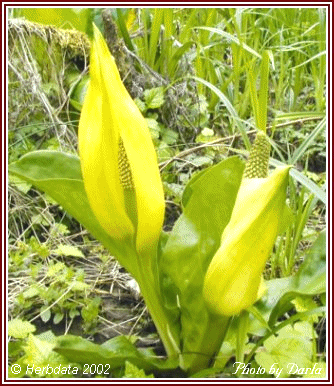

Dracontium foetidum, Linn
Common names: Skunk-cabbage, Skunk-weed, Meadow-cabbage, Polecat-weed, Foetid hellebore.
Nat. Ord. Araceae.
Parts Used: The rhizome, roots and seeds of Dracontium foetidum, Linn
Preparation: Tincture of Symplocarpus.
History. It is indigenous, growing plentifully in various parts of the United States, in moist grounds, flowering in March and April, and maturing its fruit in August and September.The whole plant has an extremely disagreeable odor, resembling the commingled odors of skunk and onions, which is most apparent when the plant is bruised, and which has given rise to the several names of Skunk-cabbage, Skunk-weed, Polecat-weed, and Meadow-cabbage. The parts used are the rhizome, with its rootlets, and the seeds. The rhizome should be gathered soon after the appearance of the spathe, or after the seeds have matured in autumn. It has the unpleasant odor of the plant.
Description and Chemical Composition. As found in commerce the drug is in somewhat cylindrical pieces, 2 inches or more in length, and about 1 inch in diameter, or, more commonly, in tranverse slices, very much compressed and corrugated. Its color externally is dark-brown, and internally whitish, or yellowish white. Drying lessens the odor as well as the acridity of the plant, and age and exposure dissipate them entirely, consequently the root should be renewed annually. The seeds have been used and preferred as being more energetic than the root. They have an exceedingly acrid taste, and emit the fetid odor of the plant only when bruised. They preserve their virtues longer than the root. The properties of this plant are chiefly owing to a volatile substance, which loses its activity by desiccation, and is completely volatilized by subjection to an increased temperature. Alcohol or water extracts its virtues.
Action, Medical Uses, and Dosage. In large doses, according to Bigelow, skunk cabbage will cause sickness at stomach, vomiting, headache, dizziness, and impaired vision. In medicinal doses it is a stimulant, exerting expectorant, powerful antispasmodic, and faintly narcotic influences. Its action upon the nervous system is marked, relieving irritation, and it has a tendency to promote normal functional activity of the nervous structures. It has been successfully used in asthma, whooping-cough, nervous irritability, hysteria, epilepsy, and convulsions during pregnancy and labor; likewise in chronic catarrh, pulmonary, and bronchial affections. The powdered root or seed may be given in doses of from 10 to 40 grains, 3 times a day; but the most eligible mode of administration is a saturated tincture of the fresh root, of which 1 or 2 fluid drachms may be given for a dose.
Abstracted and abridged from:
King's American Dispensatory.
by Harvey Wickes Felter, M.D., and John Uri Lloyd, Phr. M., Ph. D., 1898.
![]()